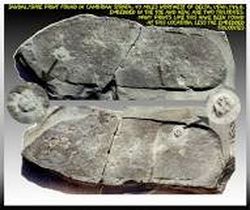(Clearwisdom.net) Modern scientists and archaeologists have found many inexplicable ancient artifacts. They appear to be the remnants of advanced civilizations and have been found throughout the world. These surviving traces of ancient cultures have been found above and underground, in mountain caves, and even on the bottoms of the oceans. These archaeological findings most likely tell us that before the emergence of human civilization, there existed other intelligent beings who built highly developed civilizations that were destroyed for inexplicable reasons.
According to textbooks, human beings have a history of no more than ten thousand years. How do we explain the ancient relics and metal products that can be dated back to many more than ten thousand years?
ST Santiago stone
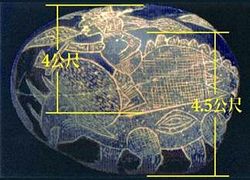 Soldiers riding on a large dinosaur (Photo: Courtesy Don Patton) |
ST Santiago Stone
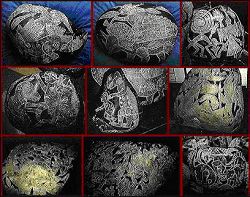 ICA Stones (Photo: Courtesy Dr. Don Patton) |
In the Nazca Plain in the northern part of Peru, there is a stone museum in a small village called Ica (ICA). The museum displays 10,000 pieces of stones engraved with mysterious patterns. They are called ICA stones. The patterns on the stones have been divided into different categories, such as the space galaxies, ancient animals, prehistoric continents, and ancient catastrophes. These classifications are totally out of touch with modern science. It is as if these discoveries challenge our historical texts.
Near the cave where the carved stones were found, there were also fossils millions of years old. The carvings are incredible. They depict men and dinosaurs coexisting, and it has been suggested that the ratio of men and dinosaurs was about the same as human beings and livestock. In other words, dinosaurs appear to have been kept as livestock or were tamed by human beings.
In addition, pictures on the stones depict organ transplants, blood transfusions, telescopes, medical equipment, men chasing dinosaurs, and much more. These scenes are hard to explain with modern science.
From the stone patterns and carvings, we can tell that there was a prehistoric human civilization that had reached a very advanced technology.
Antikythera Device from Greece
 On October 17, 2005, during the 2nd International Conference on Ancient Technology, this display showed "Antigone Jisela computer" imitations. (Photo by LOUISA GOULIAMAKI/AFP/Getty Images) |
A century ago, a computer called the Antikythera Mechanism was discovered in a sunken shipwreck along the Greek coast. Its bronze high gear and turnable disc are so complex that it cannot be replicated even today, and no one can figure out how it functions.
Recently, scientists from the United Kingdom, Greece, and the United States used high-definition x-ray tomography to look at one of its models. Scientists made a further analysis: the Antikythera Mechanism can add, subtract, multiply, compute, and explain astrophysics, with regard to the moon and positions of planets. It has a calibration disc and may be able to predict solar or lunar eclipses.
Today we understand that the Antikythera Mechanism was used in the second century B.C. Allegedly, this was the very first calculator in history.
South African Metal Balls
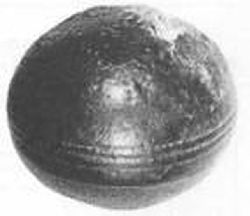 Hundreds of metal balls with grooves were found at on a hillside near a lake in South Africa. They have a history of 2.8 billion years. (Photo: Rolfe Marx) |
More than ten years ago, miners in South Africa dug up some metal balls in the vicinity where Transvaal Ottosdal pyrophyllite ore is found. These metal balls are about one inch in diameter; some of them are engraved with three circular grooves in the middle of the balls. It appears that these balls are from the Precambrian geological age, which was 2.8 billion years ago.
The grooves on these metal balls are almost intact, even after billions of years. Some believe that they are relics from a prehistoric civilization. We ask ourselves, "Who made these metal balls, and for what purposes were they made?" They have yet to be studied by experts and scholars.
Ancient Model Airplanes
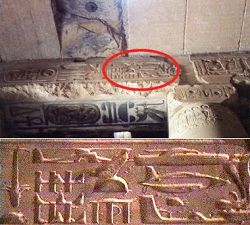 Models of aircraft from murals in the Egyptian ruins of the Temple of Abydos (Photo from internet) |
In 1879, British archaeologists found murals in the Abydos Temple, located near Egypt's Cordovez, a barren desert. The murals depict a few objects that look like today's aircraft and a series of similar flying objects, including a helicopter, a submarine or a spacecraft, and even a "UFO." These carvings have a history of three thousand years.
Mankind's first aircraft was manufactured in 1903, but strangely enough, on the ancient Egyptian murals, models of aircraft appeared as early as three thousand years ago.
In 1898, someone found a very similar model of an aircraft in a four-thousand-year-old Egyptian tomb. It was made of wood from small fig trees that grew in the area at that time. That model is stored in the Museum of Antiquities in Cairo.
In 1969, anthropologist Dr. Carryl Mishaboshi found ancient artifacts in the museum's warehouse. They were models of "birds." Each bird is half-man and half-bird with bird feet. These models have their wings spread out, a supine body, a vertical tail, and the marking of a falling, horizontal tail. They look very much like the single-wing aircraft of today.
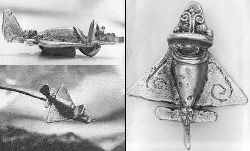 A golden airplane model found in South America looks similar to modern B52 bombers (Photo from internet) |
Even more incredible is that airplane models, looking very similar to the Egyptian airplanes, were found in South America. In one South American country, a golden ancient airplane model that looks very similar to a B52 bomber was unearthed. According to the scientists, this model not only has a sophisticated design but can also fly.
Baghdad, Iraq, Battery
 Baghdad, Iraq, third century BC batteries. (Photo from internet) |
In June 1936, a group of construction workers accidentally found an ancient grave outside the Iraqi capital of Baghdad. After more than two months of excavation, archaeologists discovered many artifacts from the Persian Dynasty, from 248 BC to 226 BC.
After looking at one item closely, German archaeologist William Carvedilol, executive director of the then Iraqi Museum, made a surprising announcement. He said that a peculiar ancient, earthenware vase about five inches tall was an ancient chemical battery. If one added an acid or alkali solution, it could be used.
Carvedilol's conclusion shocked the archaeologists, and it means that as early as the third century BC the Persians living in the region already had batteries. It is two thousand years earlier than the first battery invented by the physicist Alessandro Volta in 1800.
US Coso Artifacts
 Coso man-made materials (Photo from internet) |
In February 1961, the residents of Coso Mountain, Olancha, California, discovered an extremely hard piece of quartz at an altitude of more than 400 feet, 40 feet higher than the Owens' riverbed.
The cut surfaces of the quartz remind one of the remnants of certain mechanical devices. Their structures display the extreme complexity of man-made materials. What is more remarkable is that the quartz can be traced back 500,000 years.
The Coso quartz has been dubbbed the "Coso Artifact" and the mysterious substance is known as the spark plug of an internal combustion engine.
Giant Stone Ball from Costa Rica
 Giant stone ball from Costa Rica |
Around the year 1930, the American George Jitan found about 200 artificial stone balls in the tropical jungle, valleys, and the slopes of the delta of Costa Rica. These stone balls vary in size. They have a diameter of two to 12 feet. They are the products of superb technology and artistry
These mysterious stone balls attracted a great deal of interest. Scientists discovered, after measuring the balls, that they are made of solid granite. The curvature on the surface is almost exactly the same from many different points. The error of the diameter is so minute that it is practically a perfectly "round" ball.
Archaeologists have said that the makers of these balls must have possessed considerable knowledge and superb carving skills. In addition, they must have had very sturdy tools and precision measuring devices, otherwise these products could not have been manufactured.
Who made these giant stone balls, and with what kind of tools, and for what purpose were they made? These questions remain unanswered. Some people call these giant stone balls, "The giant's marbles."
Fossils with Impossible Footprint
 Trilobites can be seen on the upper left corner (Photo: Creation Evidence Museum) |
In 1938, Dr. Bailey, the head of a geological institute in Kentucky, found 10 identical human footprints in the carboniferous sandstones. Microscopic photos and infrared photographs show that these footprints were caused by the pressure from human feet rather than artificial carving. It is estimated that the rocks with these footprints are about 250 million years old.
Before 1938, two human footprints were discovered on a rock in St. Louis on the Mississippi River's west bank. According to geologists, that rock is about 270 million years old.
Trilobites are small, marine invertebrates that existed on the earth from 600 million years ago to 280 million years ago, when they became extinct. Amateur fossil expert William J. Meister discovered a few fossils from the Precambrian age at Antelope Springs, Utah, in June, 1968. One of the fossils has shoe prints of an adult and a child.
The renowned chemist Melvin A. Cook from Utah University has dated it and said that they are indeed human footprints.
In July, 1968, a well-known geologist, Dr. Bodike, personally went to Antelope Springs and discovered the footprint of a child. In August, 1968, a public school special-education worker from Salt Lake City found two human shoe prints on the same piece of rock containing trilobites fossil. All of these discoveries and their dating by scholars have eliminated any doubts about their existence. They present a serious challenge to traditional geology.




